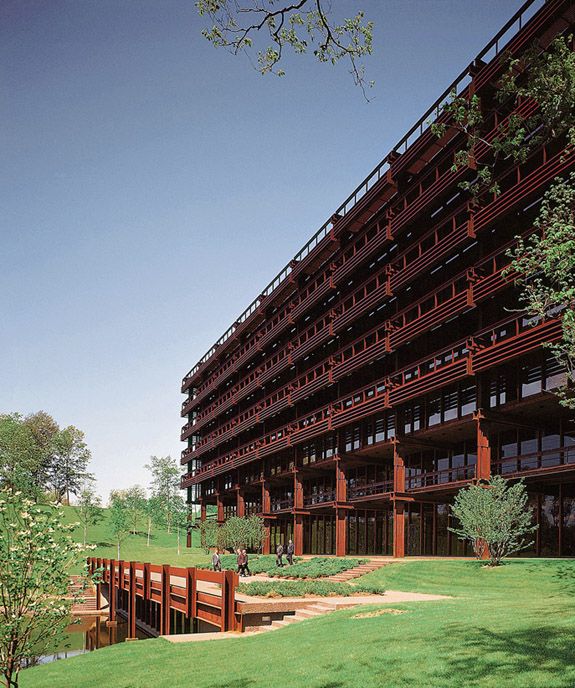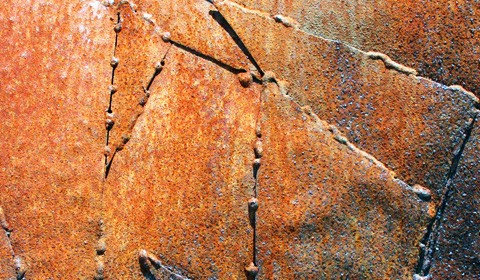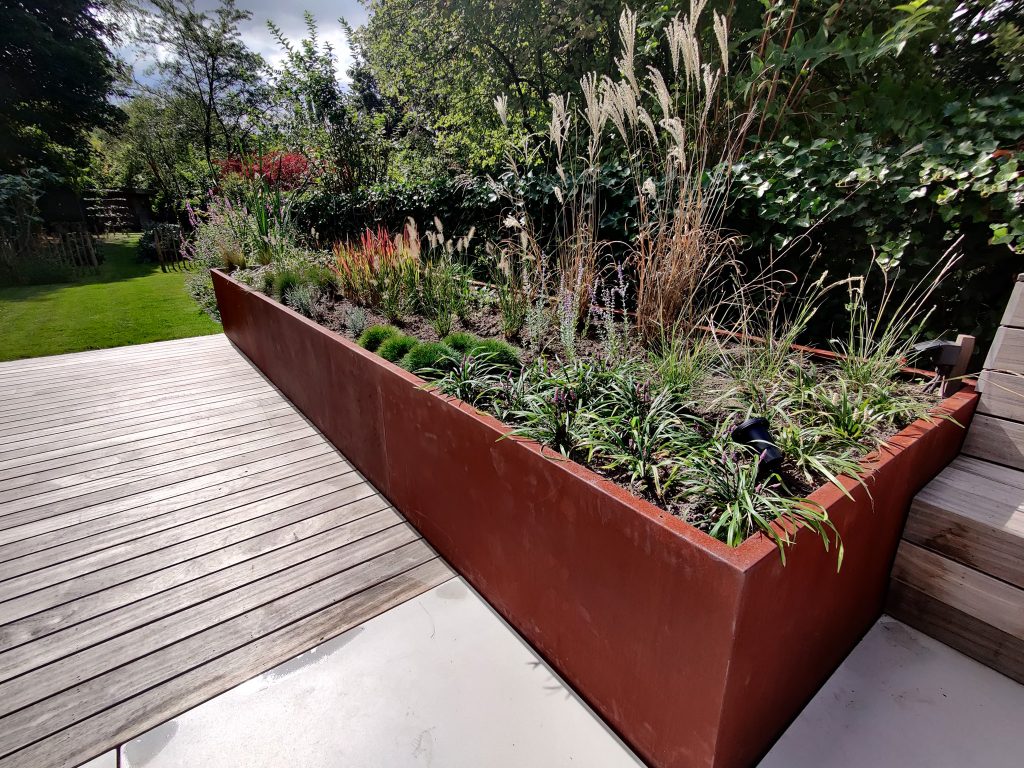COR-TEN (Corten) Steel
COR-TEN (Corten) Steel
The term Cor-ten.
The term Cor-ten derives from the abbreviation of the terms that define its main characteristics, CORrosion restistance and TENsile strength. In fact, it holds great success precisely for its high resistance to corrosion and high mechanical resistance to traction.

BACKGROUND.
COR-TEN steel was patented by the United States Steel Corporation (USS) in 1933. It was launched as a low alloy steel with 0.2-0.5% copper, 0.5-1.5% chromium and 0 , 1-0.2% of phosphorus. Very popular in America where it is used on a large scale, it has now found numerous confirmations also in Europe and in other countries. It is usually highly appreciated for its peculiarities that combine aesthetics with performance. Its composition has varied over the years. For example, 0.4% nickel was introduced and phosphorus reduced to 0.04%. Small contents of other elements have also been introduced in order to improve mechanical resistance. The best Corten on the market today reach yield strengths up to 580 MPa.
Among the first applications as structural steel in construction stands the John Deere and Co Headquarters (Illinois) in 1964, designed by architect Eero Saarinen.

Protective patina of Cor-ten steel (Corten).
Corten steel is a versatile material with extraordinary structural and aesthetic properties.
The main peculiarity of COR-TEN steel is to protect itself from electrochemical corrosion. This is possible through the formation of a compact passivating surface patina, consisting of the oxides of its alloying elements. The patina prevents the progressive spread of corrosion and varies in shade over time. It usually has a brown color. It is composed of a porous outer layer and an amorphous inner layer, very thin and waterproof, rich in copper, chromium and phosphorus.
How Corten oxidizes.
Usually, under standard environmental conditions, this coating forms in about 18-36 months. Its color varies from an initial orange to a reddish brown shade (classic rust color). This gives the material a protective but at the same time aesthetic effect. The surface of the material is uniformly opaque and usually the sheets are installed pre-oxidized. However, there are cases in which the elements are assembled when the oxidation state is in the initial phase. Some companies such as Corten + allow this oxidation to be achieved in two hours thanks to surface treatment products. Cor-ten steel is defined as a living metal because when the surface patina is nicked or scratched, the oxidation process restarts, restoring the protection.
Oxidation conditions.
However, the passive formation of the protective film occurs under certain conditions. First of all, alternating dry/wet cycles are required as the protective oxide film is formed with the alternation of continuous wetting and drying. Contact with the atmosphere and the action of sunlight and the absence of permanent stagnation with water are also important. It is also important that no substances (paints, waxes and varnishes) are applied before the formation and growth of the passivating protective oxide film. The cor-ten must not be placed in the vicinity of chlorides such as sea water. These in fact prevent the formation of the film or can promote corrosion. If these conditions are not met, the protective film does not form and COR-TEN steel behaves like a common carbon steel.
Types of COR-TEN steel (Corten).
There are mainly three types of Corten:
• COR-TEN type A, also called phosphorus Corten, often used for architectural applications. It has a resistance to atmospheric agents from 5 to 8 times higher than that of carbon steel;
• COR-TEN type B, or vanadium Corten, used for structures with medium stress. It has a resistance to atmospheric agents about 4 times higher than that of common carbon steel;
• COR-TEN type C, mainly used for highly stressed structures. It has a resistance to atmospheric agents about 4 times higher than that of carbon steel.
COR-TEN products have characteristics that meet the requirements of the ASTM standards.
ASTM International has defined standards A242 (COR-TEN A), A588 (COR-TEN B) and A606 for thin sheets.
COR-TEN A Steel.
Corten type A has great resistance to attack by atmospheric agents. On average it resists five to eight times more than a common carbon steel.
It is the steel that is most suitable for use without protective surface treatment. It is particularly appreciated in “architectural” applications thanks to its pleasant appearance.
In standard environmental situations, the corrosion of the unpainted COR-TEN A stops after causing a decrease in thickness of about 50 micrometers. In a marine environment, however, it progresses slightly over the years. However, always to a lesser extent than the corrosion found in common carbon steels.
COR-TEN A is normally produced in thicknesses of up to 12.5 mm.
PERCENTAGE CHEMICAL COMPOSITION – CASTING ANALYSIS
C <= 0,12 ; Mn 0,20 – 0,50 ; P 0,07 – 0,15 ; S <= 0,035 ; Si 0,25 – 0,75 ; Cu 0,25 – 0,55 ; Cr 0,30 – 1,25 ; Ni <= 0,65
Cor-ten B Steel.
This type of COR-TEN, otherwise known as Corten with Vanadium, is characterized by its ability to maintain high mechanical characteristics even in high thicknesses. It has a resistance to corrosion in the atmosphere about four times higher than that of common carbon steel.
Like COR-TEN A, type B is also used without surface treatment. The result from an aesthetic point of view, however, although similar, is a little poorer.
Considering the possibility of producing products in greater thicknesses, even over 100 mm, COR-TEN B steel is well suited for structural applications. In the field of construction, both corrosion resistance and high mechanical resistance are required.
PERCENTAGE CHEMICAL COMPOSITION – CASTING ANALYSIS
C 0,10 – 0,19 ; Mn 0,90 – 1,25 ; P <=0,025 ; S <= 0,035 ; Si 0,15 – 0,30 ; Cu 0,25 – 0,40 ; Cr 0,40 – 0,65 ; V 0,02 – 0,10
Cor-Ten C Steel.
COR-TEN C is the most recently introduced type on the market. It always maintains a resistance to atmospheric corrosion that is about four times higher than that of carbon steels but with a mechanical resistance much higher than the other two types. Type C is suitable for the most demanding applications where the mechanical resistance must be very high. For example, it is used in complex architectural projects where stresses are very important.
The thicknesses generally produced go up to 25 millimeters but for the profiles the maximum thickness is even lower.
PERCENTAGE CHEMICAL COMPOSITION – CASTING ANALYSIS
C 0,12 – 0,19 ; Mn 0,90 – 1,35 ; P <=0,025 ; S <= 0,035 ; Si 0,15 – 0,30 ; Cu 0,25 – 0,40 ; Cr 0,40 – 0,70 ; V 0,04 – 0,10
WORKABILITY of COR-TEN steel (Corten)
COLD BENDING
The cold bending of COR-TEN is generally carried out up to not too high thicknesses, approximately under 12.5 mm. Obviously, it is essential to always respect the minimum radii of curvature indicated by the manufacturers of the material. For higher thicknesses or more extreme bending, we move from cold bending to hot bending.
HOT FORMING
Hot forming of COR-TEN is not particularly problematic. It is usually recommended to heat the material to a temperature not exceeding 1,100 ° C and to finish the forming operation at a temperature between 815 ° C and 900 ° C.
Following hot forming, in the cooling phase, the material generally does not harden significantly. In the presence of a forming performed correctly, it is therefore possible to avoid subsequent heat treatments. Below 650 ° C hot forming is strongly not recommended.
WELDING
The methods generally used to weld COR-TEN steel are: arc welding with coated electrodes, submerged arc, arc under protective gas and resistance. Carbon Manganese steels have characteristics similar to those of Corten. For this reason, the same filler materials used for welding these steels are often used.
When COR-TEN has been used untreated for aesthetic purposes, the welding is carried out in more than two passes. Using specific electrodes it is possible to obtain cords with a color similar to that of oxidized Corten. The minimum preheating temperatures are very important and must always be respected.

Advantages of COR-TEN (Corten) steel.
Corten steel has established itself on the market because it has some interesting advantages.
First of all, it has a very competitive cost compared to normal steels. Thanks to the high mechanical resistance it is possible to reduce the thickness of the parts and therefore reduce the weights.
The resistance to atmospheric corrosion allows the use of corten even without subsequent surface finishes and this aspect is obviously a source of savings.
Over time, the material does not degrade from an aesthetic point of view but rather increases its appeal. It is no coincidence that architects and designers are very attracted to it.
Always for the same reasons it is not necessary to carry out maintenance or cleaning operations on the pieces.
Corten is suitable for processing in many ways such as forging, bending, drawing, laser cutting and welding. It is also very durable, non-deformable and obviously 100% recyclable as it is natural.
Disadvantages of COR-TEN (Corten) steel.
When the water touches the surfaces, the steel releases iron ions. The precipitation of these causes rust-colored castings on the surfaces adjacent to the Corten details. Generally, channels are prepared for the collection of rainwater on the sides of the Corten pieces to limit this problem.
HOW TO RECOGNIZE THE FALSE CORTEN.
Given the spread and interest aroused by COR-TEN steel, systems have also appeared on the market to emulate its characteristics.
A first method to simulate the aesthetic effect is metallization. A thin layer of Corten is applied to ordinary steel in order to simulate its aesthetic effect. The problem, however, is that if the surfaces are scratched or damaged there is no spontaneous regeneration of the material. Imperfections are therefore always visible.
A second method is to use paints that reproduce the rust effect. Locally the effect is similar but the visual effect on a wider view is totally devoid of the strong variegation characteristic of Corten.
Finally, it is possible to pass common steel as COR-TEN steel by letting it oxidize and then rust. The effect is quite similar but with the passage of time the rust tends to peel off. The surfaces therefore lose their regularity and flatness and become very irregular.

COR-TEN steel applications.
Today the contexts in which Cor-ten is used are the most disparate.
- projects with integration between architecture, landscape and art;
- details for interiors and exteriors that require a strong characterization in terms of elegance or industrial style;
- objects and accessories for outdoor or public outdoor spaces and urban furniture. For example planters, waste bins, bollards, benches, etc.
- borders that enclose and contain soil allowing to create flower beds, slopes and small slopes;
- Indoor or outdoor flooring sheets or flooring inserts of other materials;
- facade cladding that takes on a characteristic and unique color according to the atmospheric conditions of the place of installation;
- load-bearing structures for building, walls, fixtures, fences;
- ingenious works with a high aesthetic content for roads such as infrastructures, road and railway bridges.
- Signs and plaques are also in great demand in the world of communication and advertising. They integrate harmoniously with the most disparate environments, from the most refined to the most industrial.